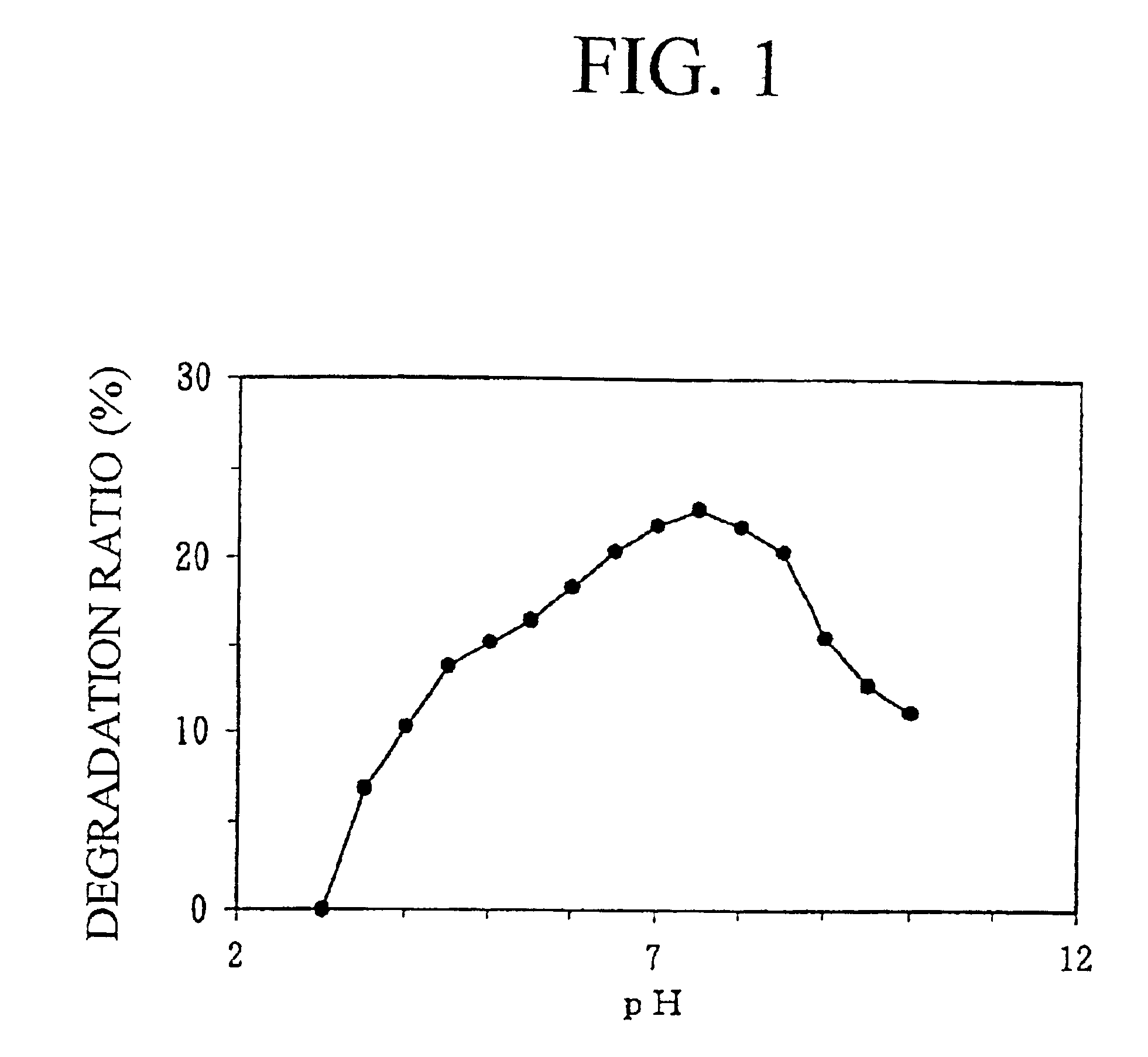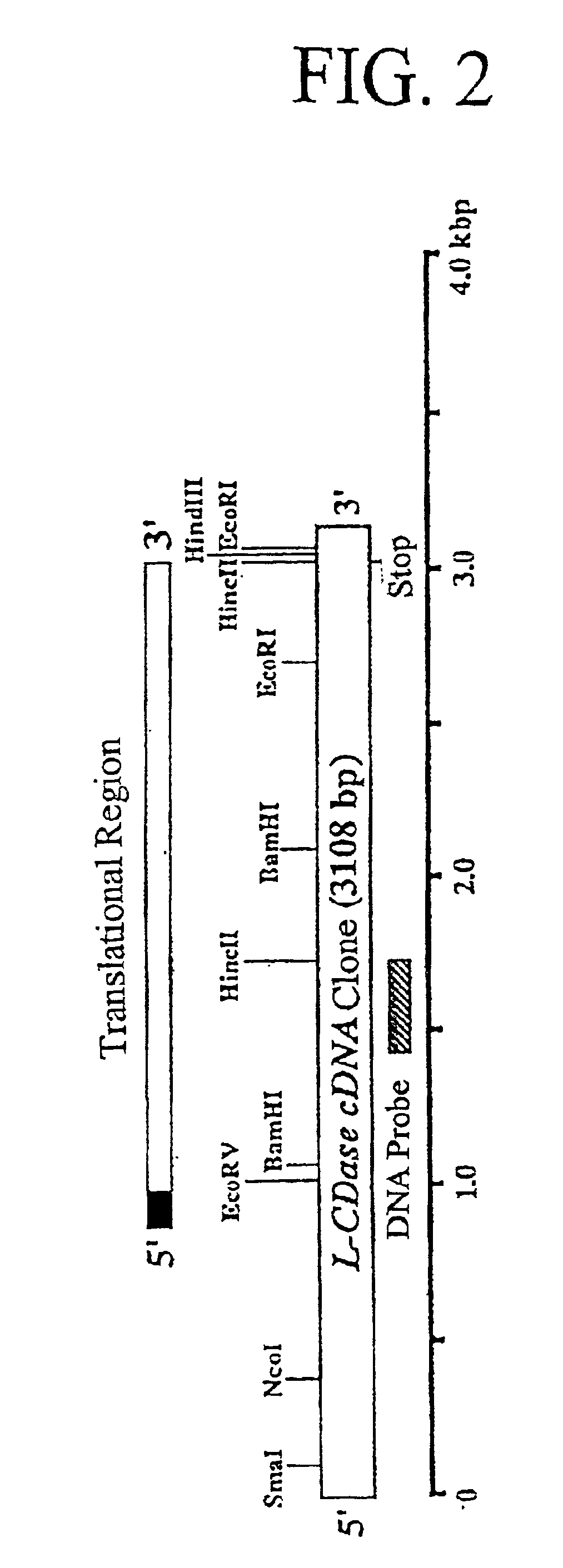Ceramidase gene
a ceramidase and gene technology, applied in the field of neutral/alkaline ceramidase gene, can solve the problems of not yet obtaining the amino acid sequence and genes thereof of the neutral/alkaline ceramidase in mammals, and it is difficult to obtain a neutral/alkaline ceramidase gene as a homolog of a nucleotide sequen
- Summary
- Abstract
- Description
- Claims
- Application Information
AI Technical Summary
Benefits of technology
Problems solved by technology
Method used
Image
Examples
example 2
Partial Amino Acid Sequencing of Ceramidase
To 11 ml of a sample solution comprising 50 pmol ceramidase was added 20 mM Tris-hydrochloric acid buffer (pH 7.5) containing 0.3% Lubrol PX. The resulting sample solution was applied onto MonoQ PCl 6 / 5 column (100 .mu.l, manufactured by Amersham Pharmacia). Subsequently, the ceramidase fraction adsorbed to the column was eluted with the same buffer containing 0.4 M NaCl. By these procedures, the ceramidase-containing fraction was concentrated to a volume of 50 .mu.l. The resulting concentrate was subjected to SDS-polyacrylamide gel electrophoresis, and the electrophoresed gel was stained with GelCode Blue Stain reagent (manufactured by Pierce). Next, the band corresponding to the ceramidase was cut out. One-quarter of the cut-out gel fragment was subjected to extraction on 300 .mu.l of 0.1 M Tris-hydrochloric acid buffer (pH 9.0) containing 0.1% SDS at 37.degree. C. for 16 hours. Using the resulting extract as a sample, the N-terminal amin...
example 3
Amplification of DNA Fragment Comprising Ceramidase Gene by PCR Method
Sense mix primer 53-S1 and antisense mix primer 53-A3 were designed and synthesized with a DNA synthesizer on the basis of the partial amino acid sequence C53 of the ceramidase determined in Example 2. SEQ ID NOs: 4 and 5 of Sequence Listing each show the nucleotide sequences of the primers 53-S1 and 53-A3. PCR was carried out by using these primers. PCR was carried out with mouse liver cDNA plasmid library (manufactured by Takara Shuzo Co., Ltd.) as a template. PCR was carried out by a reaction of 94.degree. C., 9 minutes; thereafter 40 cycles of reaction, wherein one cycle comprises a process consisting of 94.degree. C., 0.5 minutes--51.degree. C., 0.5 minutes--72.degree. C., 1 minute; and further an incubation at 72.degree. C. for 7 minutes. By this PCR, a specific amplified DNA fragment of a size of about 70 bp was detected on agarose electrophoresis.
This amplified DNA was collected from the gel, and this DNA ...
example 4
A transformant resulting from introducing the mouse liver cDNA plasmid library was inoculated to a nylon filter (trade name Hybond-N.sup.+, manufactured by Amersham Pharmacia) on an LB agar medium plate containing 100 .mu.g / ml ampicillin, and about 30000 colonies were formed per one plate of 9.5.times.13.5 cm to prepare a master filter. A replica of this filter was prepared, and the resulting replica filter was respectively treated for 5 minutes on a filter paper immersed in a 10% SDS solution; 5 minutes on a filter paper immersed in a solution containing 0.5 M NaOH and 1.5 M NaCl (denaturation); 5 minutes on a filter paper immersed in 0.5 M Tris-hydrochloric acid buffer (pH 7.5) containing 3 M NaCl (neutralization); and 5 minutes on a filter paper immersed in 2.times.SSC solutions. Thereafter, the filter was rinsed with 2.times.SSC solution. This filter was air-dried, and thereafter DNA was immobilized on a filter by ultraviolet ray irradiation to be used ...
PUM
| Property | Measurement | Unit |
|---|---|---|
| pH | aaaaa | aaaaa |
| fluorescent wavelength | aaaaa | aaaaa |
| fluorescent wavelength | aaaaa | aaaaa |
Abstract
Description
Claims
Application Information
 Login to View More
Login to View More - R&D
- Intellectual Property
- Life Sciences
- Materials
- Tech Scout
- Unparalleled Data Quality
- Higher Quality Content
- 60% Fewer Hallucinations
Browse by: Latest US Patents, China's latest patents, Technical Efficacy Thesaurus, Application Domain, Technology Topic, Popular Technical Reports.
© 2025 PatSnap. All rights reserved.Legal|Privacy policy|Modern Slavery Act Transparency Statement|Sitemap|About US| Contact US: help@patsnap.com


